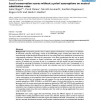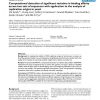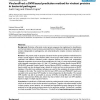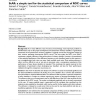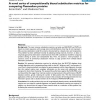BMCBI
2008
13 years 11 months ago
2008
Background: Comparative genomics aims to detect signals of evolutionary conservation as an indicator of functional constraint. Surprisingly, results of the ENCODE project revealed...
BMCBI
2008
13 years 11 months ago
2008
Background: DNA microarrays are used to investigate differences in gene expression between two or more classes of samples. Most currently used approaches compare mean expression l...
BMCBI
2008
13 years 11 months ago
2008
Background: Though microarray experiments are very popular in life science research, managing and analyzing microarray data are still challenging tasks for many biologists. Most m...
BMCBI
2008
13 years 11 months ago
2008
Background: Prediction of bacterial virulent protein sequences has implications for identification and characterization of novel virulence-associated factors, finding novel drug/v...
BMCBI
2008
13 years 11 months ago
2008
Background: Microarray experiments generate vast amounts of data. The functional context of differentially expressed genes can be assessed by querying the Gene Ontology (GO) datab...
BMCBI
2008
13 years 11 months ago
2008
Background: In the past decades, various protein subcellular-location (SCL) predictors have been developed. Most of these predictors, like TMHMM 2.0, SignalP 3.0, PrediSi and Phob...
BMCBI
2008
13 years 11 months ago
2008
Background: As in many different areas of science and technology, most important problems in bioinformatics rely on the proper development and assessment of binary classifiers. A ...
BMCBI
2008
13 years 11 months ago
2008
Background: With advances in DNA re-sequencing methods and Next-Generation parallel sequencing approaches, there has been a large increase in genomic efforts to define and analyze...
BMCBI
2008
13 years 11 months ago
2008
Background: The most common substitution matrices currently used (BLOSUM and PAM) are based on protein sequences with average amino acid distributions, thus they do not represent ...
